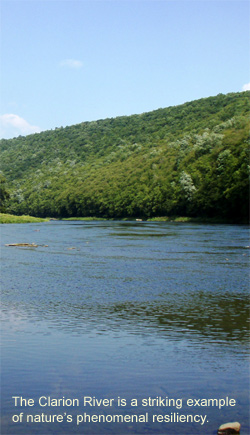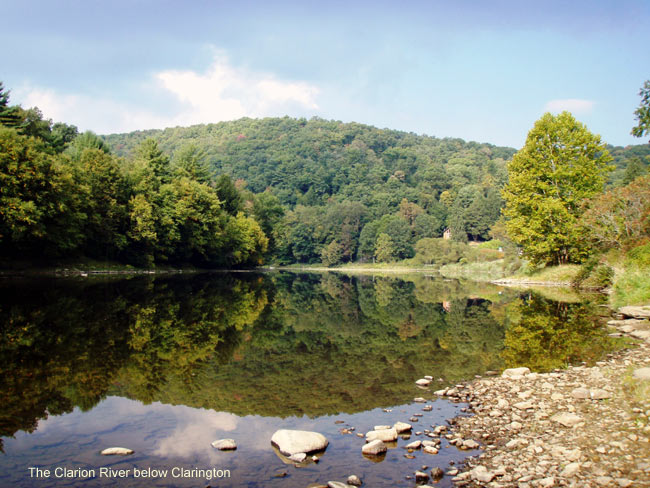|
Conserve |
|
|
The Allegheny River |
| A River in Three Parts |
| Allegheny Islands |
| Life at the Bottom |
| French Creek |
| Little Mahoning Creek |
| Past Issues |
| Home |
Answering the Clarion Call
By Chuck Williams
Watershed Manager, Upper Allegheny
 The Clarion River flows nearly 100 miles southwest from its headwaters in McKean County to its meeting with the Allegheny River near Parkers Landing, Clarion
County. The Clarion River watershed, with more than 1,100 square miles of land and water, is among the largest in the Upper Allegheny River Basin, a close second in size only to French Creek, its biologically diverse neighbor to the west. A key tributary of the Upper Allegheny River both ecologically and historically, the Clarion River is also a striking example of nature’s phenomenal resiliency.
The Clarion River flows nearly 100 miles southwest from its headwaters in McKean County to its meeting with the Allegheny River near Parkers Landing, Clarion
County. The Clarion River watershed, with more than 1,100 square miles of land and water, is among the largest in the Upper Allegheny River Basin, a close second in size only to French Creek, its biologically diverse neighbor to the west. A key tributary of the Upper Allegheny River both ecologically and historically, the Clarion River is also a striking example of nature’s phenomenal resiliency.
The creeks and rivers of the Upper Allegheny Basin are rich in aquatic
life, particularly mussels, dragonflies, and fish. Unfortunately, few historic
records of the Clarion’s aquatic life exist, so our understanding of the
River’s past flora and fauna is thin. The Clarion’s direct link to the rich
Allegheny River likely influenced the diversity of life in its waters. Aquatic
organisms like fish and the hellbender, a large aquatic salamander,
probably moved easily between the two rivers, a flow of life sustained by
clean and connected waters. Perhaps even certain species of mussels
lived in the Clarion, moving along the river on fish that unwittingly played
host to the mussels’ parasitic larvae.
But the flow of life in the Clarion River began to ebb by the early 1900s. In 1909, Carnegie Museum biologist Arnold E. Ortmann tagged the Clarion as ‘one of the worst streams in the state” for industrial pollution. Tanneries, chemical wood plants, and a pulp plant dumped their noxious wastes into the River’s upper reaches. Acid drainage from coal mines tainted its lower reaches. Ortmann’s description of the Clarion at the time is graphic: “The water of the Clarion River...is black like ink and retains its peculiar color...to where it empties into the Allegheny.” A 1915 sanitary survey of the Clarion River noted that “fish have been practically exterminated.”
And so it stood until the 1960s, when a multifaceted effort to clean up the Clarion River took hold. Recognizing the comeback potential of the river and the scenic and recreational value of the lands surrounding it, the late Roger Latham, WPC board member and outdoors editor of The Pittsburgh Press, urged the Conservancy to focus conservation efforts in the region. WPC eagerly took up the challenge. To date, WPC has protected 11,600 acres along what is now a federal Wild and Scenic River and regional treasure. To aid in recreation and plan for the River’s future, WPC and partners also completed a water trail map and the recent Clarion River Greenway Plan.
With a little help, the formerly downtrodden Clarion River is rebounding. Some mine drainage problems remain in the lower river, but it’s clear that the phoenix-like comeback of the Clarion River is great news for the water, land, and life of the Upper Allegheny Basin.
Chuck Williams is WPC’s Watershed Manager for the Upper Allegheny River. Chuck is very familiar with the history, culture, geography, and ecology of the watershed, having conducted research there for nearly 15 years in conjunction with the U.S. Forest Service and other entities. He’s authored two books on the history of the Allegheny Watershed and is a former professor and chair of biology at Clarion University.

